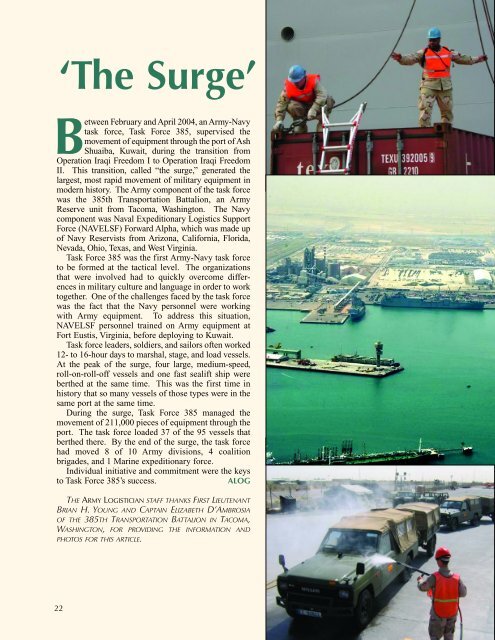Supporting the First Stryker Brigade in Iraq - Army Logistics ...
Supporting the First Stryker Brigade in Iraq - Army Logistics ...
Supporting the First Stryker Brigade in Iraq - Army Logistics ...
You also want an ePaper? Increase the reach of your titles
YUMPU automatically turns print PDFs into web optimized ePapers that Google loves.
‘The Surge’<br />
Between February and April 2004, an <strong>Army</strong>-Navy<br />
task force, Task Force 385, supervised <strong>the</strong><br />
movement of equipment through <strong>the</strong> port of Ash<br />
Shuaiba, Kuwait, dur<strong>in</strong>g <strong>the</strong> transition from<br />
Operation <strong>Iraq</strong>i Freedom I to Operation <strong>Iraq</strong>i Freedom<br />
II. This transition, called “<strong>the</strong> surge,” generated <strong>the</strong><br />
largest, most rapid movement of military equipment <strong>in</strong><br />
modern history. The <strong>Army</strong> component of <strong>the</strong> task force<br />
was <strong>the</strong> 385th Transportation Battalion, an <strong>Army</strong><br />
Reserve unit from Tacoma, Wash<strong>in</strong>gton. The Navy<br />
component was Naval Expeditionary <strong>Logistics</strong> Support<br />
Force (NAVELSF) Forward Alpha, which was made up<br />
of Navy Reservists from Arizona, California, Florida,<br />
Nevada, Ohio, Texas, and West Virg<strong>in</strong>ia.<br />
Task Force 385 was <strong>the</strong> first <strong>Army</strong>-Navy task force<br />
to be formed at <strong>the</strong> tactical level. The organizations<br />
that were <strong>in</strong>volved had to quickly overcome differences<br />
<strong>in</strong> military culture and language <strong>in</strong> order to work<br />
toge<strong>the</strong>r. One of <strong>the</strong> challenges faced by <strong>the</strong> task force<br />
was <strong>the</strong> fact that <strong>the</strong> Navy personnel were work<strong>in</strong>g<br />
with <strong>Army</strong> equipment. To address this situation,<br />
NAVELSF personnel tra<strong>in</strong>ed on <strong>Army</strong> equipment at<br />
Fort Eustis, Virg<strong>in</strong>ia, before deploy<strong>in</strong>g to Kuwait.<br />
Task force leaders, soldiers, and sailors often worked<br />
12- to 16-hour days to marshal, stage, and load vessels.<br />
At <strong>the</strong> peak of <strong>the</strong> surge, four large, medium-speed,<br />
roll-on-roll-off vessels and one fast sealift ship were<br />
ber<strong>the</strong>d at <strong>the</strong> same time. This was <strong>the</strong> first time <strong>in</strong><br />
history that so many vessels of those types were <strong>in</strong> <strong>the</strong><br />
same port at <strong>the</strong> same time.<br />
Dur<strong>in</strong>g <strong>the</strong> surge, Task Force 385 managed <strong>the</strong><br />
movement of 211,000 pieces of equipment through <strong>the</strong><br />
port. The task force loaded 37 of <strong>the</strong> 95 vessels that<br />
ber<strong>the</strong>d <strong>the</strong>re. By <strong>the</strong> end of <strong>the</strong> surge, <strong>the</strong> task force<br />
had moved 8 of 10 <strong>Army</strong> divisions, 4 coalition<br />
brigades, and 1 Mar<strong>in</strong>e expeditionary force.<br />
Individual <strong>in</strong>itiative and commitment were <strong>the</strong> keys<br />
to Task Force 385’s success. ALOG<br />
THE ARMY LOGISTICIAN STAFF THANKS FIRST LIEUTENANT<br />
BRIAN H. YOUNG AND CAPTAIN ELIZABETH D’AMBROSIA<br />
OF THE 385TH TRANSPORTATION BATTALION IN TACOMA,<br />
WASHINGTON, FOR PROVIDING THE INFORMATION AND<br />
PHOTOS FOR THIS ARTICLE.<br />
22<br />
JANUARY–FEBRUARY 2005







